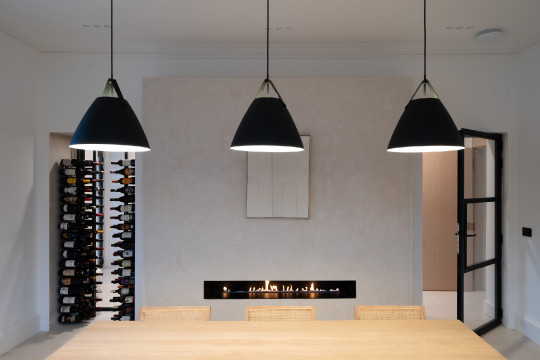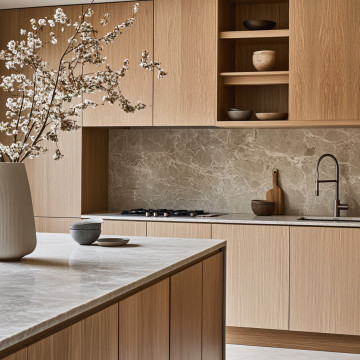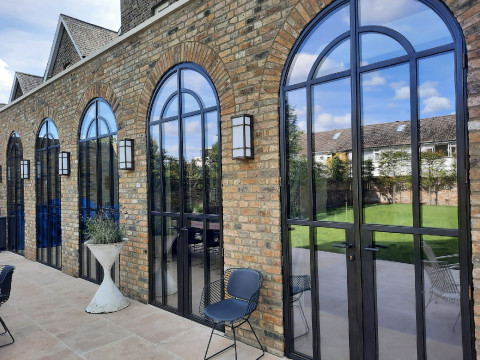2024/2025 Trends in Scottish Architecture
13th December 2024Each year, although our projects are diverse in style and location, we notice architectural design trends emerging. In this, our 25th year in practice, a few themes stand out.
The first is the ever-greater focus on lighting design, which is always an interesting and creative aspect of how a space works and can change the whole feel of a building. Next is that there’s no slow-down in the mid-century modern cabinetry boom, and the third trend is a rise in requests for traditional-style extensions featuring classical design detailing. We’ve also seen more call for LVT surfaces, aka luxury vinyl tiling, which is having a significant moment owing to its ability to accurately mimic more expensive materials like marble and wood. There’s also a call for some beautiful ceiling detailing – we always remind clients to consider ceilings – they can be the source of a key design statement (Sistine chapel, anyone?). And finally, the striking punctuation of black-framed windows are having a renaissance, echoing both industrial design and the traditional Scottish cottage.
Read on for all the details
Internal lighting – a shift away from downlights
We've observed a growing preference for surface-mounted or suspended track lighting, shifting away from ubiquitous recessed downlights. This reflects the influence of mid-century modern design, where track lighting was a hallmark. In our contemporary projects, black has emerged as the favoured colour for fittings, complementing clean, minimalist interiors. Home automation, including lighting controls, is also popular, not least because they can be programmed for effective energy saving. And that means less shouting at family members to turn off tech and lights!


Enduring appeal of mid-century modern cabinetry and kitchens
The nostalgic appeal of mid-century kitchen styles continues to surge in popularity. If you have an original G-Plan cabinet or Ercol table hidden away, it’s time to get it valued! The warm-wood tones of this furniture offer timeless appeal – the aesthetic still feels fashionable and modern. Part of its success is its deliberate functionality – the Bauhaus design movement assertively championed practicality. Equally important is its easy ability to blend with contemporary design, making this cabinetry an easy choice for many, even if it’s only part of the design picture.


Easy to look after LVT, aka luxury vinyl flooring
While we’re not always champions of imitation materials, there’s no denying the rise in desire for LVT flooring. Clients looking for versatility, durability, and low maintenance understandably find it hard to resist. It’s true that LVT successfully mimics the appearance of premium materials like wood, stone, and marble, offering a modern alternative to traditional flooring options. Its durability is down to a successful design system made up of five key layers: A UV coating for colour protection, a durable wear layer that protects against scratches and stains, a decorative layer replicating the look and feel of the natural material, a core layer for stability and water resistance, and a backing layer for additional comfort and sound absorption.
LVT’s pros include being engineered to withstand heavy foot traffic, scratches and moisture, so it’s ideal in high-use areas such as kitchens and bathrooms. It’s also warmer underfoot than stone, too. An increasing number of manufacturers offer LVT made from recycled materials and low-VOC products, appealing to environmentally conscious clients, although we have noted that the inclusion of PVC isn’t necessarily very eco-friendly.


Traditional extensions with intricate design detailing
Classical detail on rural timber buildings is part of the vernacular in Sweden, Norway, Denmark, and in parts of America such as Cape Cod and Martha’s Vineyard, too. The buildings are peppered with forms familiar to the western eye, although for us in Scotland we are more used to seeing those forms in stone.
With the introduction of acetylated timber or Accoya, to use the brand name, timber external components last for decades longer than they would before. Building this way is still cheaper than in stone and in many ways a lot easier. This means there is an opportunity here to use the product imaginatively in the classical language – for example profiled columns and intricate external cornicing – in the knowledge that even in our climate the buildings will last. We have adopted this approach on projects including garden room extensions where a rich detail can be an appropriate way of expressing the importance of the space and introducing delight to an element which is often on the side or rear elevation of the property.


Stunning ceilings – don’t forget to look up
Thoughtfully designed ceilings significantly enhance the overall sophistication of a space. We encourage clients building luxury homes to view the ceiling as the sixth plane, using it to elevate the quality of their interiors. Vaulted ceilings with exposed trusses have become particularly sought after this year, ranging from sleek and minimal to rustic in style, and really celebrating exceptional materials like oak. For flat ceilings, coffered designs are an effective way to zone and define larger open-plan areas, and some lovely design can be included to really show that attention to every detail is part of the fabric of your home.


Punctuating house design with black-framed windows
Black-framed windows have become a design favourite for their striking contrast. Throughout the history of home design, they have made their appearance – in the white cottages of Scotland’s islands to the industrial appeal of warehousing and metal windows. Black complements and accentuates a particular palette of materials which includes clear timber external cladding and soffits, stonework, and white render, creating a wonderfully crisp aesthetic. The simplicity of black frames enhances both contemporary and traditional designs. They also frame views as if you’re looking at a picture, drawing attention to the surrounding landscape.


[Photo: IQ Glass]
